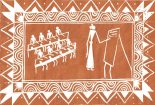Sora language is the largest of the Koraput Munda languages. It is spoken in two neighboring states – in the south of Odisha and in the north of Andhra Pradesh, as well as by the local groups in Assam and Arunachal Pradesh states. The number of its speakers is estimated as 310 thousand.
The sociolinguistic situation in the Sora–speaking area shows a remarkably interesting multifaceted picture. Multilingualism among Soras is based on the knowledge of their native language, languages of the neighboring tribes and ethnic groups, the official language of the state (Oriya and/or Telugu) and the official languages of the country, which are Hindi and English. Thus, among others, the Lanjiya Sora group speaks the native Sora language, Oriya, Hindi and English, and in addition, they live together with the Pano caste group, speaking a dialect of Oriya, and both groups know the languages of each other to some extent.
The processes of modernization, the dominance of Indo-Aryan languages and English in the mass media, Internet, at schools and official institutions of India, the low prestige of the Munda languages due to the widespread perception of the tribes as “underdeveloped” because of their low position in caste hierarchy – all these phenomena lead to linguistic and cultural assimilation and language loss by younger generation.
For example, some Sora, speaking only the Oriya language, find it difficult to even identify their tribal affiliation. They classify themselves just as a “scheduled tribe”. However, due to the relatively large number of speakers, Sora currently is in a better situation compared to other Munda languages, such as Gorum, Bonda and Didayi, which have the status of “severely endangered” (“serious danger of extinction”) according to the UNESCO Atlas of the World’s Languages in danger.
At the same time, the number of Sora speakers decreases rapidly due to the above-mentioned trends. With school education getting more and more widespread, a “hostel generation” appears: children in the remote villages from early age are sent to boarding schools. In these hostels their native language is partly or fully prohibited in order to develop better Oriya skills. Of course, these “hostel” children lose their native language.
By religion, Sora belong to five different confessions. In addition to the Sora groups that adhere to traditional animistic beliefs, there are Baptist, Catholic and Hindu communities, formed as a result of Christian and Hindu missionaries’ activity, and the neoanimist religion “Matar Banom”. The followers of “Matar Banom” worship as a deity the recently invented writing system for Sora language.
Each religious community has its own special sociolinguistic situation. For example, in Baptist communities the services are done in Sora (with some addition of Oriya), by Sora speakers; Sunday service attendance is required for the entire community; the Sora translation of the Bible and various religious texts are regularly read and performed. Thus, the religious tradition contributes to (sometimes even secondary) acquisition of the native language.
At the same time, in the Catholic communities priests mostly come from different, often southern, regions of the country, where Christianity is more prevalent. Many of them are native speakers of Dravidian languages, they learn Oriya in varying levels of proficiency specifically to conduct liturgy in this language. For that reason, services and confessions are conducted in Oriya (with addition of Hindi and English), religious texts in Sora exist, but are not read en masse. All this negatively affects Sora language.
There are four writing systems for Sora with differing degrees of standardization. Two of them, based on Oriya and Telugu scripts, are adapted to Sora for methodological purposes, because the Indian Government MultiLingual Education (MLE) program, which organizes teaching in mother tongues in elementary schools, requires training in the script of state’s official language. Both scripts can be used to write in Sora by followers of any religion.
In addition, there is Roman-based script for Sora. It is used by Christians of both the Baptist and Catholic communities. There are old and new graphic varieties of Roman script. The old graphics was developed by Rao Sahib G.V. Ramamurti on behalf of the Canadian Baptist Mission in 1930s. It reflects many features of Sora phonetics and contains elements of the International Phonetic Alphabet. The new graphics uses English alphabet only without any additional characters: this facilitates the development of writing, but poorly reflects the phonetic features of the language. Religious literature now exists in both scripts.
The autochthonous sacred writing system Sorang Sompeng was invented along with the neoanimistic religious movement “Matar Banom” (1936). In this movement both the script and the language are sacred. Of course, all the religious activities (services, compilation of religious literature) of Matar Banom are made exclusively in Sora.
Education in Odisha and Andhra Pradesh states is conducted in the official languages of the states – Oriya and Telugu, there are also educational institutions teaching in English. As a part of the MLE program, in some villages the elementary school teaching is conducted in Sora. Besides, there are ashrams teaching children in Sora with a writing basis of Sorang Sompeng, within the “Matar Banom” community.
As of now, there is no dialectological description of Sora language. For example, many years it has been debated whether Juray is a separate language or a Sora dialect. Our work with Juray revealed that this idiom is extremely close to Sora, but has been more deeply influenced by Oriya. There is a large number of lexical and grammatical borrowings from Oriya in it, e.g., the original Juray numerals were replaced by Oriya numerals. The Juray speakers identify themselves as Sora.
Language idioms of Sora tribal groups are traditionally distinguished as Sora dialects. They vary historically by geographical and professional characterictics and have formed a peculiar caste system (Lanjiya Sora, Sarda Sora, Rayka Sora, Arsid Sora, etc.), but this classification has no linguistic basis. In addition, depending on the state of residence, the groups of Oriya Sora and Telugu Sora are distinguished, because their languages are influenced by the official languages of the states.

